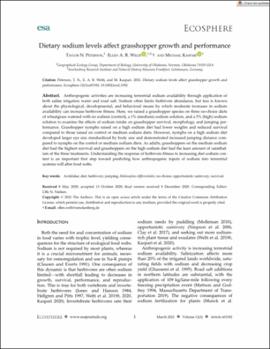| dc.contributor.author | Peterson, Taylor N. | |
| dc.contributor.author | Welti, Ellen A.R. | |
| dc.contributor.author | Kaspari, Michael | |
| dc.date.accessioned | 2021-06-02T14:58:27Z | |
| dc.date.available | 2021-06-02T14:58:27Z | |
| dc.date.issued | 2021-03-08 | |
| dc.identifier.citation | Peterson, T. N., E. A. R. Welti, and M. Kaspari. 2021. Dietary sodium levels affect grasshopper growth and performance. Ecosphere 12(3):e03392.10.1002/ecs2.3392 | en_US |
| dc.identifier.uri | https://hdl.handle.net/11244/330059 | |
| dc.description.abstract | Anthropogenic activities are increasing terrestrial sodium availability through application of both saline irrigation water and road salt. Sodium often limits herbivore abundance, but less is known about the physiological, developmental, and behavioral means by which moderate increases in sodium availability can increase herbivore fitness. Here, we raised a grasshopper species on three no-choice diets of wheatgrass watered with no sodium (control), a 1% (medium) sodium solution, and a 5% (high) sodium solution to examine the effects of sodium intake on grasshopper survival, morphology, and jumping performance. Grasshopper nymphs raised on a high sodium diet had lower weights and reduced survival compared to those raised on control or medium sodium diets. However, nymphs on a high sodium diet developed larger eye size standardized by body size and demonstrated increased jumping distance compared to nymphs on the control or medium sodium diets. As adults, grasshoppers on the medium sodium diet had the highest survival and grasshoppers on the high sodium diet had the least amount of cannibalism of the three treatments. Understanding the response of herbivore fitness to increasing diet sodium content is an important first step toward predicting how anthropogenic inputs of sodium into terrestrial systems will alter food webs. | en_US |
| dc.description.sponsorship | NSF DEB-1556280 awarded to MK including a REU award to TNP supported this project. Open Access fees paid for in whole or in part by the University of Oklahoma Libraries. | en_US |
| dc.language | en_US | en_US |
| dc.rights | Attribution 4.0 International | * |
| dc.rights.uri | https://creativecommons.org/licenses/by/4.0/ | * |
| dc.subject | Acrididae | en_US |
| dc.subject | Diet | en_US |
| dc.subject | Herbivory | en_US |
| dc.subject | Jumping | en_US |
| dc.subject | Melanoplus differentialis | en_US |
| dc.subject | No-choice | en_US |
| dc.subject | Opportunistic carnivory | en_US |
| dc.subject | Survival | en_US |
| dc.title | Dietary sodium levels affect grasshopper growth and performance | en_US |
| dc.type | Article | en_US |
| dc.description.peerreview | Yes | en_US |
| dc.identifier.doi | 10.1002/ecs2.3392 | en_US |
| ou.group | College of Arts and Sciences::Department of Biology | en_US |


